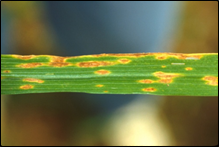Tan Spot in Wheat
Tan Spot
Symptoms

Tan Spot
University of KY Dept. Plant Pathology
Symptoms of tan spot appear as small yellow brown spots that develop into broad oval or lens-shaped light brown blotches on leaves, usually with a yellow border. As lesions merge, large areas of leaves turn yellow or brown and die. Tan spot lesions are difficult to distinguish from lesions resulting from Stagonospora nodorum infection. Tan spot lesions, however, are devoid of pycnidia, tend to remain more discrete, and have more distinct yellow halos. Small dark brown spots often develop at the center of tan spot lesions.
Tan spot is usually most evident late in the season, but can occur early, prior to flag leaf development, especially where continuous wheat is grown.
Cause
The fungus responsible for tan spot development survives the winter in infested wheat stubble. Spores are produced and infect plants throughout the spring during extended periods of leaf wetness. Shortened or continuous wheat rotations and reduced tillage practices encourage tan spot development.
IPM Techniques
- Varieties resistant to tan spot are available in wheat, but tan spot reactions of many commonly grown varieties are poorly defined.
- Rotate fields out of wheat for two or more years.
- Avoid excessively dense, lush stands.
- Till under infested wheat stubble after doublecrop soybeans are harvested.
References and Additional Information
- IPM-4 Kentucky IPM Manual for Small Grains
- PPA-10c Kentucky Plan Disease Management Guide for Small Grains by D.E. Hershman and Paul Vincelli
- Annual Kentucky Small Grain Variety Trials, Progress Report 355
- PPA-36 Fungicides to Control Leaf Diseases in High Yield Wheat
- Selecting Wheat Varieties, Grain Gleanings, Vol. 1, No. 9 (1993)
- Foliar Fungicides Use in Wheat, Grain Gleanings, Vol. 1, No. 3 (1993)
- Compendium of Wheat Diseases, M.V. Wiese, The American Phytopathological Society Press, 1987.
Wheat Diseases and Wheat Insects Menu


